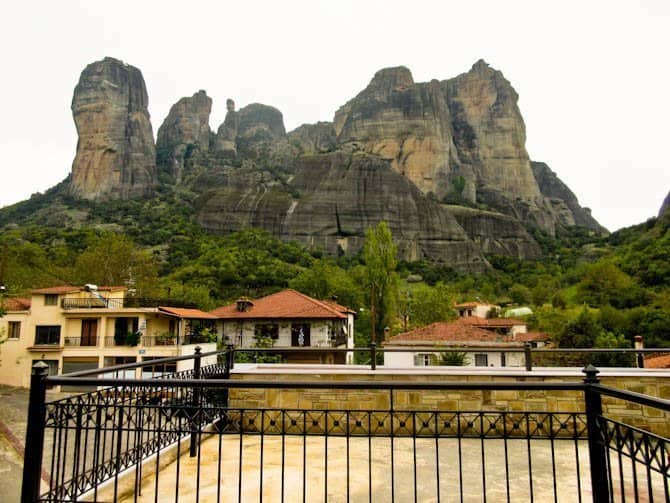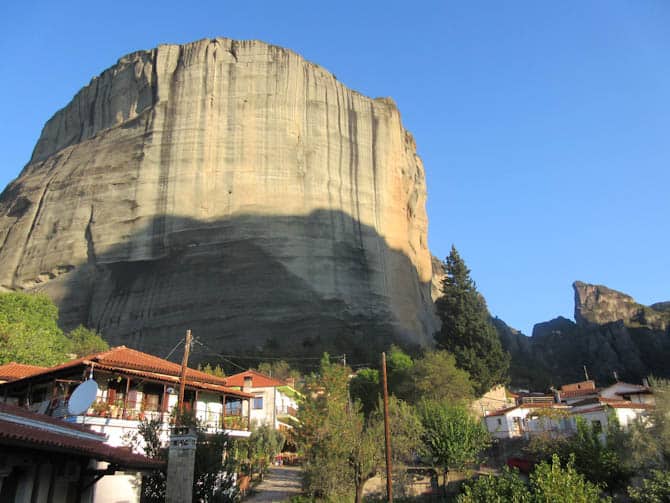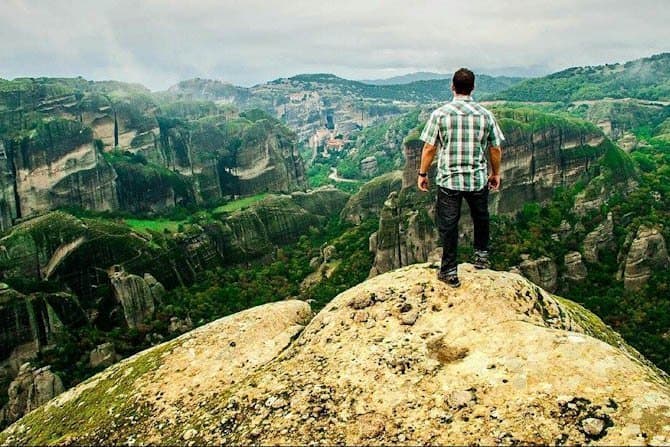*Updated April, 2016
One glimpse of the massive rocky pinnacles in Meteora and you’ll agree that you are witness to one of the most striking natural creations in Greece. Definitely a site worthy of the UNESCO World Heritage list. What may not be as immediately obvious is the equally impressive and awe-inspiring creations of man that sit perched atop these imposing towers.
While attending a conference in Athens we met with George of Visit Meteora who invited us to come and experience this spectacular site for ourselves with him as our guide. We are so grateful to have met George as there are so many great places to visit in Greece that we may have missed out on this magical experience. Less than two weeks after our meeting we boarded a train headed for Kalambaka on the plains of Thessaly and arrived at the site of Meteora.
Loading up our packs we staggered up a steep street to find our hotel, all the while looking up in awe. Alsos House (our hotel) sits at the foot of one the statuesque rock formations that greeted us upon arrival. Formations which were created over millions of years by a combination of receding ocean water, earthquakes and erosion. These stone skyscrapers tower intimidatingly over the town casting a dark shadow in a reminder of how immense and powerful nature can be.


After checking in at Alsos House we went to the Visit Meteora office located in the center of town. “There is a good trail right behind your hotel and if you leave now you can make it to the first monastery and back before sunset.” said George, our host. “Tomorrow we will hike to four of the other great Greek monasteries of Meteora.”
Not wanting to waste a minute we packed up the cameras and flashlights and started our ascent. Although steep and a bit rough in parts the trail was well marked and fairly easy to navigate. Being nature lovers and believers in a Fit Living Lifestyle it felt really good to be out in nature and working our muscles. The scenery was lovely and we knew by the occasional break in the trees that we would be rewarded with a great view at the top. Still, we weren’t prepared for just how spectacular it would be.



Arriving at the Agia Triada (Holy Trinity) Monastery we paid the small fee (about $3) and donning a borrowed skirt at the entrance we walked through the still-functioning monastery admiring the art and the stone architecture.
However, the real prize was revealed when we emerged from the back entrance and were greeted by a view so breathtaking that we both just stopped awestruck. It wasn’t until that moment that we became aware of what an impossible and beautiful location this sanctuary sat in. Later we would learn just how truly remarkable it really was.
The name Meteora is Greek for ‘suspended in the air’ and indeed we felt as though we were. We clambered over the sandstone and conglomerate rocks, stood at the edge of the cliffs and sat gazing out over the valley below taking photo after photo until the grounds keeper signaled that it was time to go. Leaving reluctantly we carefully navigated our way back down in the dusky light and went into town in search of dinner.



The next morning we awoke to a clear blue sky for which we felt really blessed as it had apparently been raining for two weeks straight. Based on our sneak peak we knew that the other monasteries of Meteora would be impressive regardless of the weather but like most places, a dry day makes for a much more pleasant experience.
We had pretty high expectations for our Meteora day hike and we were definitely not disappointed. Comprised of some of our favorite things: nature, exercise and historic sites the day couldn’t have been better if we’d planned it ourselves. We were a group of twelve ranging in age from about six to sixty and hailing from all parts of the world including a group of university students from India.
Together we chatted as we followed a 9 km circular route which took us through pine and deciduous tree covered mountains and valleys and to the top of the rock towers where the famous Greek Orthodox monasteries were perched. The full tour took about 6 hours but there were plenty of breaks including time in the beautiful monasteries themselves.
Along the way, George taught us about the native plants, animals and over 800 types of different rocks that made up the terrain. He also gave us an overview of the history and geography of the area and the monasteries themselves.




The first Byzantine inhabitants in the area were Hermetic monks starting in the 11th century. They would climb the massive rocks and make sanctuaries high up in caves in order to be alone with and closer to God. They then stayed in these caves their whole lives and were dependent upon pilgrims for food and water which was hoisted up in rope nets.



Much later, in the 14th and 15th centuries, monasteries were built and flourished and totaled 24 by the year 1500. These monasteries were constructed under impossible conditions with no roads or heavy equipment. Everything had to be painstakingly collected, hauled up the cliff face and built by hand by the monks themselves. Things remained much the same until the 1920’s when steps were carved into the rock allowing for easier access.



Today only six of the monasteries survive and are in use, Great Meteoron, Agia Triada, Varlamm, Agios Stefanos, Roussanou and Agios Nikolaos Anapafsas. They are used mainly for touristic purposes, four are cared for by monks and two are nunneries.
It is said that the monks initially chose this location for the natural protection and strategic positioning but as you stand at the top of these pinnacles you have to wonder whether there was more to it than that. There is definitely a very special energy in this place that brings a sense of peace and serenity. In fact, many of the locals ascend the mountains when in need of just that. They say it helps to heal their souls and brings clarity and peace of mind. Maybe the monks sensed this energy all those centuries ago or maybe those same centuries of selfless worship have created it. Either way, it is a very special place and worthy of the name Magical Meteora.



As our tour came to an end and we were driving back into town our previously chatty group was quiet. Most likely in part tired from the hike and hungry for lunch but also I think just lost in thought as we processed what we had just seen. The combination of millions of years of natural creation plus the incredible determination, tenacity, and faith of man in the building of these sanctuaries really is almost unbelievable. It is difficult enough to fathom after having seen it first hand, but to try to describe it with word and picture is almost impossible. For this reason, Meteora and the impressive monasteries should without a doubt be on everyone’s must-see list when in Greece.
Things To Know
How to get there: Easily accessible from Athens it is about a 4 ½ hour train, bus or car ride. Rome2Rio is a good site to give you an idea of transportation.
Where to stay: You will not find top luxury resorts in Kalambaka but there are plenty of decent if basic options. In peak season it is definitely best to book ahead. We use Hotels Combined for an overview of the best rates or you can contact Visit Meteora for more assistance.
When to go: Meteora is accessible year round but they do get all seasons so dress accordingly.
Tour or not to tour: You can definitely visit the monasteries and do some of the hikes on your own but if you want to see more of the countryside (which is spectacular) and learn an incredible amount of history and geography of the area a tour is the way to go. We did one day on our own and one day on a guided tour and enjoyed both days equally. Either way, stop in at Visit Meteora to pick up some information on what to see and do.
Tips
- If hiking solo or on tour bring a backpack with snacks, water and sunscreen.
- Wear good walking/hiking shoes even if you are not hiking as the stone stairs can be uneven and the climb is quite high in some of the monasteries.
- Bring a camera!!! You will take a hundred photos easily.
- Hike up the Agia Triada for sunset but bring a flashlight for the way back down.
- Men cannot wear shorts and women must wear skirts in the monasteries. They do have wrap skirts on loan at the entrances.
- All the monasteries charge a small fee to enter (usually not included in the tour price). You may not want to pay to enter all six but definitely go into at least a couple. They are all beautiful but we would say not to miss the Agia Triada for the views which can only be accessed by going through the monastery. The Great Meteoran and the Varlaan are the largest and probably the most popular.
If you enjoyed this post and want to save it for later why not Pin it!

Born in England, Sarah developed her wanderlust at a young age as she traveled around Europe with her parents. As a young adult she spent every penny she could on experiences as opposed to possessions. Eventually she found a way to earn a living doing what she loved: traveling, writing and capturing images of the wondrous world we live in. When not on the go Sarah enjoys time in her “sometimes home” of Vancouver.


